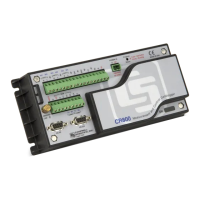Section 8. Operation
302
8.1.5.2.2 Low-Frequency Mode
Low-frequency mode enables edge timing and measurement of period (not period
averaging) and frequency. For information on period averaging, see Period
Averaging
(p. 307).
Edge Timing (C1 - C4)
Time between pulse edges can be measured. Results can be expressed in terms of
microseconds or Hertz. To read more concerning edge timing, refer to CRBasic
Editor Help for the TimerIO() instruction. Edge-timing resolution is
approximately .
Edge Timing (C1 - C4)
Open collector (bipolar transistors) or open drain (MOSFET) sensors are typically
measured as frequency sensors. Channels C1 – C4 can be conditioned for open
collector or open drain with an external pull-up resistor as shown in figure Using
a Pull-up Resistor on Digital I/O Channels C1 - C4
(p. 303). The pull-up resistor
counteracts an internal 100-kΩ pull-down resistor, allowing inputs to be pulled to
> 3.8 V for reliable measurements.
8.1.5.3 Pulse Measurement Tips
• The PulseCount() instruction, whether measuring pulse inputs on pulse
channels (P1 through P2) or on digital I/O channels (C1 – C4), uses
dedicated 24-bit counters to accumulate all counts over the user-specified
scan interval. The resolution of pulse counters is one count or 1 Hz.
Counters are read at the beginning of each scan and then cleared. Counters
will overflow if accumulated counts exceed 16,777,216, resulting in
erroneous measurements.
• Counts are the preferred PulseCount() output option when measuring the
number of tips from a tipping bucket rain gage or the number of times a door
opens. Many pulse output sensors, such as anemometers and flow meters, are
calibrated in terms of frequency (Hz
(p. 433) ) so are usually measured using the
PulseCount() frequency option.
• Accuracy of PulseCount() is limited by a small scan-interval error of ±(3
ppm of scan interval + 10 µs), plus the measurement resolution error of ±1 /
(scan interval). The sum is essentially ±1 / (scan interval).
• Use the LLAC4
(p. 538) module to convert non-TTL level signals, including
low-level ac signals, to TTL levels for input into digital I/O channels C1 –
C4.
• When digital I/O channels C1 – C4 measure switch-closure inputs, pull-up
resistors may be required. Figure Connecting Switch Closures to Digital I/O
(p. 303)
show how pull-up resistors can be incorporated into a wiring scheme.
• As shown in figure Connecting Switch Closures to Digital I/O
(p. 303), digital
I/O inputs, with regard to the 6.2-V Zener diode, have an input resistance of
100 kΩ with input voltages < 6.2 Vdc. For input voltages ≥ 6.2 Vdc, the
inputs have an input resistance of only 220 Ω.

